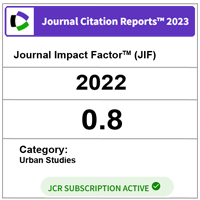Outreach of Pro-poor Housing Programs and Projects: Is it sustained?
DOI:
https://doi.org/10.11113/ijbes.v3.n1.107Abstract
Affordable housing for urban poor is one among the hot button issues among all policy makers and planners in countries of global south. Grand schemes with extravagant promises in the formal sector and gigantic hope for informal sector, to capture the opportunity at bottom of pyramid, are simultaneously trying to curb the problem of affordable housing shortage for urban poor. Even though private sector does not purposely seek to cater housing for lower income sections, yet large quantum of investment have been witnessed in housing for the urban poor. It is well known that in a free market tussle, the highest bidder is always the winner. This has been a major reason for creation of artificial shortage of housing for poor. And the scenario is worse in case of public housing, where, half of the units are either left purposeless or used by ineligible users, largely due to risk of impoverishment and improper post occupancy vigilance. The magnitude of post occupancy problems being unexplored, the objective of paper pertains to looks at the challenges and issues in sustaining targeted outreach to intended beneficiaries in housing supply models for urban poor. The paper elaborates distinct challenges through three housing supply models in Ahmedabad, India. The models are Rehabilitation Housing, Subsidized Housing by government and market provided Housing. The method is mixed method i.e. qualitative and quantitative research using primary and secondary data sources. The critical analysis of effective outreach is carried by studying policy rhetoric in each of the models to on ground veracity in the post occupancy stage of model by assessing end user satisfaction in each model.
References
Agarwal, Jain and Karamchandani (2013). State of the Low-Income Housing Market. Monitor Deloitte.
AMC. (2013). Housing Status of AMC under various programs. Ahmedabad: AMC.
AMC. (2013). Proposal for scheme EWS under AHP. Ahmedabad: AMC.
Annez,Bertaud,Patel,Phatak (2010). Working with Market: Approach to reduce urban slums in India. World Bank.
Associationchairman (2015, April). Reasons for backing out from Private Model. (Dubagunta, Interviewer)
Batra, L. (2009). A Review of Urbanisation and Urban Policy in Post-Independent India. New Delhi: Centre for the Study of Law and Governance.
Census of India (2011). Primay Census Abstract Data, Census of India. Delhi: Government of India.
Census of India. (2011). Primary Census Abstract for Slum. New Delhi: Office of the Registrar General & Census Commissioner.
Dubagunta, G. (2015). Critical Assessment of Affordable Housing Supply Models. Ahmedabad: CEPT University.
Gandhi, S. (2012). Economics of Affordable Housing in Indian Cities : The Case of Mumbai. Environment and Urbanization, 221-235.
Gandhi, S. (2012). Economics of Affordable Housing in Indian Cities : The Case of Mumbai. Environment and Urbanization, 221-235.
GRIHAPravesh. (2015, April). (G. Dubagunta, Interviewer)
Hawtrey, K. (2009). Affordable Housing Finance.
Kamath, L. (2012). New Policy Paradigms and Actual Practices in SLum Housing. Economic and Political Weekly, p. 11.
Mahadevia,Datey,Mishra. (2013). Foisting Mass Housing on the Poor:Lessons from Social Audit of BSUP. Ahmedabad: CUE.
MHUPA. (2012). Report of Technical group on urban housing shortage. Delhi: GoI,MoHUPA,NBO.
MHUPA. (2012). Task Force Report on Promoting Affordable Housing.
Monitor. (2010). Building houses, financing homes. Monitor.
Patel, S and R Mandhyan. (2014). Impoverishment assessment of slum dwellers after off-site and on-site relocations: a case of Indore. Commonwealth Journal of local governance (15).
Patel, Sliuzas and Mathu. (2015). The risk of impoverishment in urban development-induced displacement and resettlement in Ahmedabad. Environment & Urbanization, 1-26.
Quan Gan and Robert J. Hill. (2008). Measuring Housing Affordability:Looking beyond the median.
Rao, M. M. (2012, February 20). 57 per cent of JNNURM houses for slum-dwellers unoccupied. The Hindu.
RICS. (2010). Practice standard Guidance notes. RICS.
Soto, H. d. (2000). The Mystery of Capital. New York: Basic Books.
The Economic Times. (2012, November 30). JNNURM poorly implemented, affected with lack of unaccountability, unfinished projects: CAG report. The Economic Times.
UN. (2014). World Urbanisation Prospects. New York: United Nations.
UNHabitat. (2014, October 6). World Habitat day, Voice from slums. United Nations Human Settlement Programme.
WGHR. (2012). Human Rights in India. WGHR.
Downloads
Published
How to Cite
Issue
Section
License
Copyright of articles that appear in International Journal of Built Environment and Sustainability belongs exclusively to Penerbit Universiti Teknologi Malaysia (Penerbit UTM Press). This copyright covers the rights to reproduce the article, including reprints, electronic reproductions or any other reproductions of similar nature.
Authors who publish with this journal agree to the following terms:
- This Journal applies Creative Commons Licenses of CC-BY-NC-SA
- Authors retain copyright and grant the journal right of publication with the work simultaneously licensed under a Creative Commons Attribution License that allows others to share the work with an acknowledgement of the work's authorship and publication in this journal.
- Authors are able to enter into separate, additional contractual arrangements for the non-exclusive distribution of the journal's published version of the work (e.g., post it to an institutional repository or publish it in a book), with an acknowledgement of its publication in this journal.
- Authors are permitted and encouraged to post their work online (e.g., in institutional repositories or on their website) prior to and during the submission process, as it can lead to productive exchanges, as well as earlier and greater citation of published work (See The Effect of Open Access).







